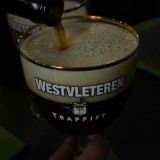For this part of our chat with Jeff McGrath, Australian Amateur Brewing Champion, we have just handed the blog over so he can share some recipes. He’s given us the three recipes that each one a first place at the Australian Amateur Brewing Championship in 2015. They are an imperial IPA (which will be pouring at GABS, a Russian Imperial Stout, and a massive 15% Imperial English Barleywine.
He’s also been kind enough to fully explain his process, water profile, and tips along the way. Part 1 can be found here.
The Process
Here is a quick run down of my process on the system all these recipes were brewed on.
I BIAB (Brew in a bag) in a 70L gas fired kettle. Usually do double batches unless its something bigger than about 6%. I mash in 50L of water and then top up pre-boil if doing a double or all the water goes in at the start for single batches.
Last Perth water report looks like for most of the year. Chloride shoots up to around 85 during winter time.
I add some gypsum to almost everything I make to increase the calcium. If its something hoppy, I shoot for 250-300ppm sulfate. Pretty much the same as what Tasty from the BN (Brewing Network) does for his hoppy beers. Gypsum goes into the mash.
Pale beers generally need a few ml of 88% lactic acid to hit a mash pH of 5.2. Dark beers usually hit 5.2 without adjustment. Really dark beers like the RIS will have the darkest grains (roasted barley, black malt) held out of the mash and then added at mash out to help keep the pH in the right spot. I whirlpool and let settle for ~20 min before chilling through a cfc. Run wort into 2 better bottles with a foil cover. Wort goes into a pre-chilled fridge until down to pitching temp. Generally 18C for ales and 8C for lagers.
Depending on how organised I am, I will use liquid if I have enough time to build up the right pitch, or use dry yeast. Dry yeast gets rehydrated.
I pitch, then add pure O2 using a Tradeflame cylinder. Bottle, reg, flow controller, sterile filter, stainless tube, 2um stone. The stainless tubing works really well, instead of having the hose trying to curl up. Most beers get 60 seconds at 1L/min. Big beers get another 30 sec dose 12 hours later.
Once FG is reached, I cold crash for a few days. If I’m dry hopping, I will add hops (loose) to another Better Bottle, purge the shit out of it with CO2, then rack across. I dry hop at ferment temp.
Pretty much everything with the exception of big beers 9%+, sours, and belgians get kegged. I noticed a huge improvement in my hoppy beers after I started kegging. Being able to purge your kegs with CO2 and keeping them cold while carbonating makes a huge difference in my mind.
When I do bottle, I purge, rack to my bottling bucket, note the volume, work out the sugar addition (table sugar) with a calculator, dissolve sugar in a small amount of just boiled water, cool a bit, pour into bucket and gently stir.
Beers that go into comps that have been kegged get filled using a Blichmann beer gun. Once you get comfortable in your process, its really easy to use.
Now for the recipes:
IIPA
Recipe based of Pliny The Elder with some hop substitutions. Such a great beer. Showcases the hops really well, with just enough malt to balance. Easy to sink a few pints.OG- 1.074
FG- 1.011
IBU- 241 (calculated)
ABV- 8.3%
21L batch @ 65% efficiency
90 min boil
Mash @ 65CPitch @ 18C, O2, rise to 20C after 4 days.
RIS
Could probably be simplified a bit, but pretty happy with this recipe. Same beer won first at Nationals in 2014 as well. Same batch. It has been kept in the fridge so I think that helped.
IBU- 94 (calculated)
ABV- 10.3%
21L batch @ 65% efficiency
60 min boil
Ingredients:
Imperial English Barleywine.
This beer was a bit of a wild card. Brewed it with a mate of mine. Made for a really really long brew day on a sunny 40C afternoon. Craziest beer I have ever made. It was so damn viscous, the hops wouldn’t settle. Hop bags would have been a wise choice. To get a gravity, I brought a sample to the lab, vacuum filtered it and diluted it 3x. Gravity came in at 1.053.
It also pretty much refuses to carbonate. I had it cold and at 20psi for 3 months and it still only like 1.5 volumes. Drinks kind of like a port, or a Sam Adams Utopias with less booze and wood character.
FG- 1.037
BU- 96 (calculated)
ABV- about 15.5%
21L batch @ 50% efficiency
240 min boil
Ingredients:
Double decoction. 63C, 70C, 75 mashout
Pitched @ 16C and held for 3 days. Was down to about 1.070 when we added the super high gravity starter. Finished at 1.045 and wouldn’t budge from there. It was too sweet at this point. We each made a small (5L) batch of dry mead. Racked mead to keg and transferred about 8L of IBW to each of our kegs. I added 40g of American Oak cubes to my keg. Dropped the FG to 1.037 while keeping the alcohol up.
Amazing info – thanks heaps to Jeff for taking the time to share these with us. He will also be around GABS so keep your eye out. I’m sure he’d be more than happy to share some knowledge and experience, or hear your attempts at recreating his beers.




1 Response
[…] Jeff McGrath – Australian Amateur Brewing Champion: Part 2 […]